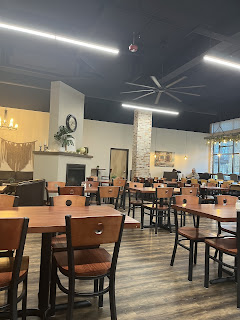The Coffee Belt & Edwards
One of the perks of being a freelance musician is getting opportunities to explore different places. I recently played with the Muscatine Symphony Orchestra for their Valentine's Day themed Masterworks concert, and in between services I had the opportunity to explore downtown Muscatine. I needed to work on some homework and answer emails, so I popped into The Coffee Belt for a drink & wifi.
The overall atmosphere was very cozy, with soft music and plenty of natural light. I was able to pop in my headphones for a productive hour. In the spirit of the holiday, I decided to try their seasonal Sweet Heart latte. It was definitely sweeter than my usual drink order, but I could still taste the espresso shots. I'm definitely looking forward to exploring another shop in April when I'll be back for their last Masterworks of the season.
Speaking of sweethearts and Valentine's Day... I wanted to focus my repertoire this week on a piece that I recently performed with my own fiancé Martin: Brad Edwards' Five American Folk Song Sketches. Edwards is currently the Professor of Trombone at Arizona State University. While an accomplished performer, Edwards is well known for his books covering a variety of pedagogical topics, such as Simply Singing for Winds which has editions for the majority of band instruments. He wrote the Five American Folk Song Sketches in 2012 and then recorded the piece with his wife, horn player Martha Mundinger Edwards. In this piece, The two instruments are written as equal partners, passing off melodic and supportive lines. Each movement is inspired by either a single folk song, or in the case of the second movement Soldier Boy, a collection of folk melodies.
The first movement is titled Black is the Color of My True Love's Hair. It is based upon an Appalachian song in which a woman yearns for her true love. The movement is in an ABA format, with a mournful and more free theme surrounding an active sixteenth note section. Measures 40 through 44 in which the two players play the same pattern slightly offset from each other is by far the most difficult part of this piece to put together.
The second movement, Soldier Boy, is influenced by multiple folk melodies, most prominently Johnny Comes Marching Home Again.
The third movement, Shenandoah, is by far my favorite to both listen to and perform. It is based upon the well known Shenandoah melody. The melody has been set to many different lyrics, usually regarding topics of love and nostalgia.
Edwards' setting of All the Pretty Little Horses is the composer's farthest departure from the original source material. While the song has unclear origins, across all settings the song functions as a lullaby. Hearing this one would initially expect the movement to be set to a slow tempo, however Edwards subverts the listener's expectations with a faster tempo and jumping eighth note figurations.
The final movement of the work is titled Dunderbeck. The original folk song tells of a man who invents a machine to turn the streets' rats and cats into sausages. This is depicted musically in multiple ways, from an eerie opening to moments where one can imagine the crank of the machine turning in a circle, grinding away. An interesting specification from the composer in this movement is the requiring of stop mute (especially wooden) during two passages. The utilization of stopped horn and harmon mute in the trombone seems almost lighthearted in contrast to the very dark subject matter of the original song. The piece ends with a dramatic fast coda, culminating in the trombone and horn landing on a unison low B-flat.






I personally like the one you played with Martin in your recital more than this recording! So much love hahah!!
ReplyDelete